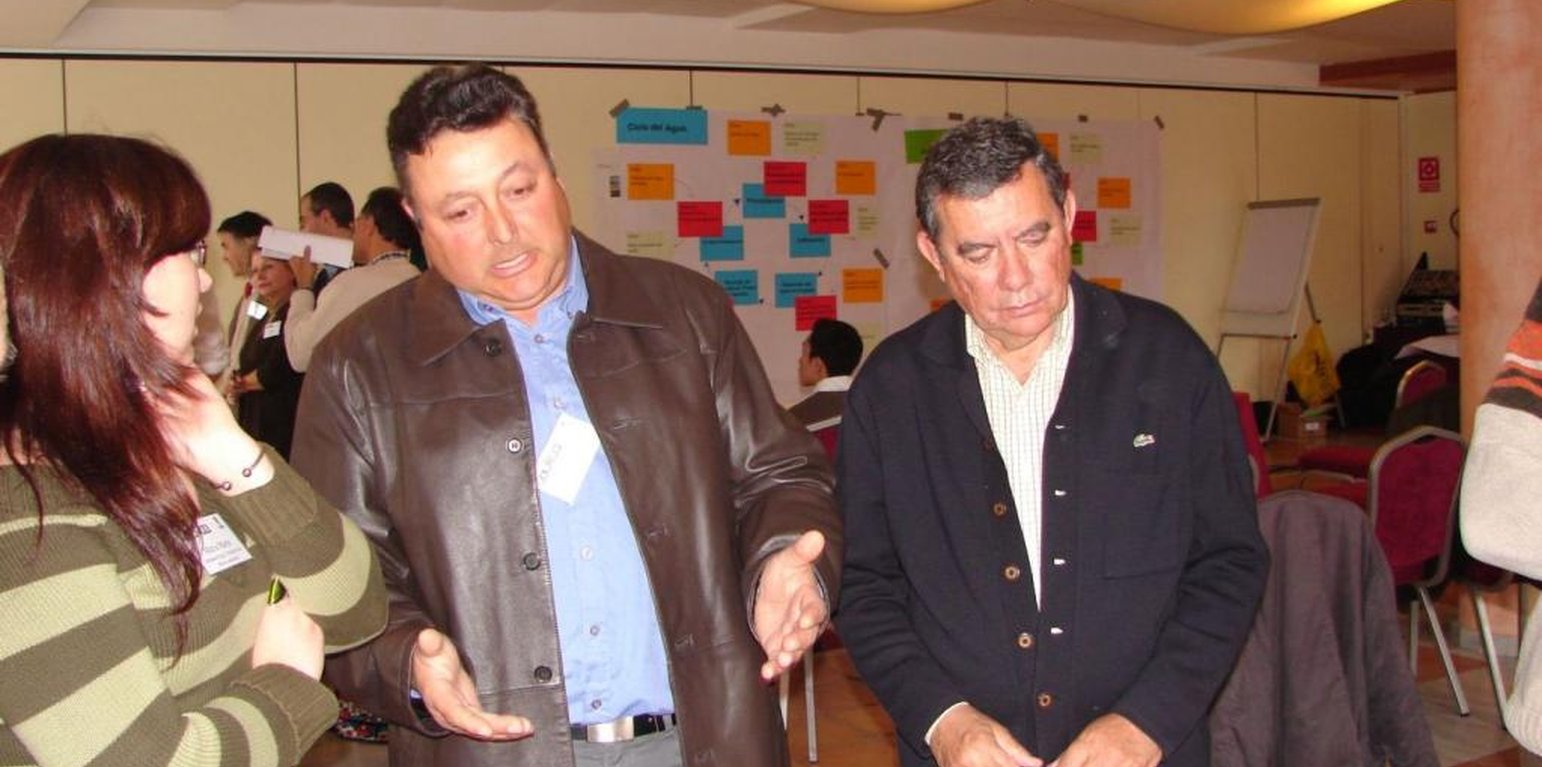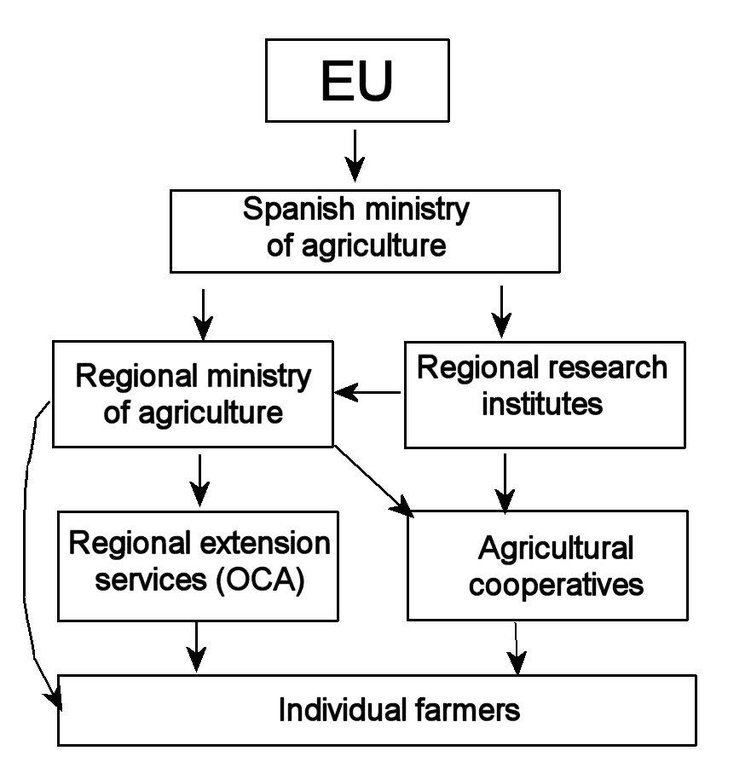Regional rural development programme
(ប្រទេសអេស្ប៉ាញ)
Programa de desarrollo rural de la región de Murcia (Spanish)
ការពណ៌នា
Regional development programme to protect natural resources and stimulate rural economies.
Aims / objectives: The objective of the Rural Development Programme (RDP) is to assist farmers who have to deal with difficult environmental conditions (drought, steep slopes) to apply sustainable farming practices either in the implementation phase or for maintenance. The programme is carried out to: 1) improve the socio-economic conditions of rural areas; 2) prevent land abandonment, and 3) prevent on-site and off-site damages caused by land degradation and erosion. To achieve these objectives, the RDP identifies different lines of action: 1) compensate for difficult natural conditions; 2) fight against erosion; 3) reduce farming intensity; and 4) promote ecological agriculture.
Methods: The main method used in the RDP is through subsidies of farming practices following a cross-compliance principle. Each line of action implies a combination of conservation measures that are subsidised, but only when applied in combination. Hence, single conservation measures outside of these lines of action are not subsidies.
Role of stakeholders: The level of the subsidy is based on estimated implementation and maintenance costs and possible loss of productivity caused by the conservation measures. These values were obtained after consultation of various stakeholder groups including farmer organisations with agricultural cooperatives. However, because of limited resources, not all farmers will receive subsidies for the conservation measures. Priority is given to: 1) farmers who have 50% of their land within the Nature 2000 network, a European wide network of protected areas for the preservation of habitats and threatened species; 2) farmers with >50% of their land in unfavourable zones; and 3) farmers who did not receive subsidy in previous RDPs.
Other important information: Furthermore, areas with slopes of more than 20% are not subsidised in this programme since it is recommended that no agriculture takes place in these areas. Instead, reforestation of these areas is subsidised. RDPs are developed for a period of 7 years. Every seven years, a new RDP is defined and priorities and levels of subsidies can change. The present RDP is valid for the period 2007-2013.
ទីតាំង
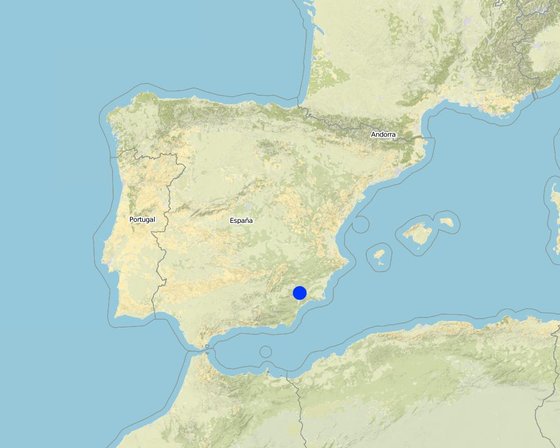
ទីតាំង: Guadalentín basin, Spain, Murcia, ប្រទេសអេស្ប៉ាញ
ចំណុចយោងភូមិសាស្ត្រនៃទីតាំងជ្រើសរើស
កាលបរិច្ឆេទចាប់ផ្តើម: 2007
ឆ្នាំបញ្ចប់: មិនមាន
ប្រភេទនៃវិធីសាស្ត្រផ្សព្វផ្សាយ
-
ក្រុមប្រពៃណី/ក្រុមជនជាតិភាគតិច
-
អ្នកផ្តួចផ្តើមក្នុងតំបន់/អ្នករុករកឃើញថ្មីៗ
-
ផ្អែកលើគម្រោង/កម្មវិធី
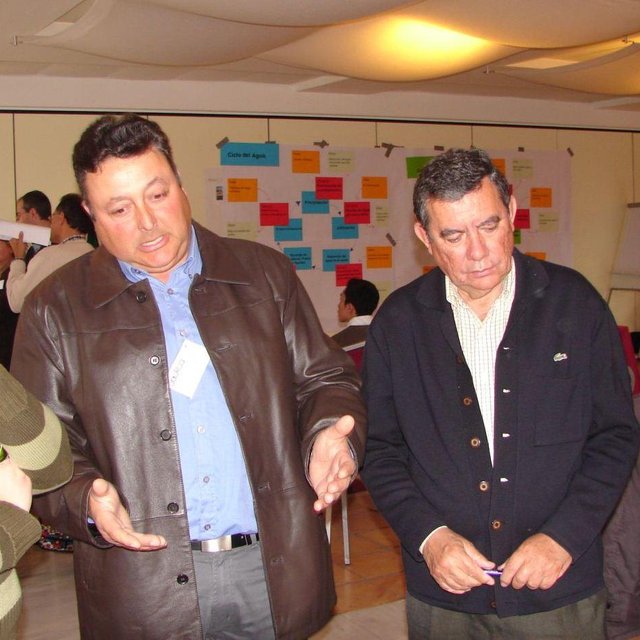
Discussion in a workshop on the usefulness of soil conservation measures and the need for agricultural subsidies. (Joris de Vente)
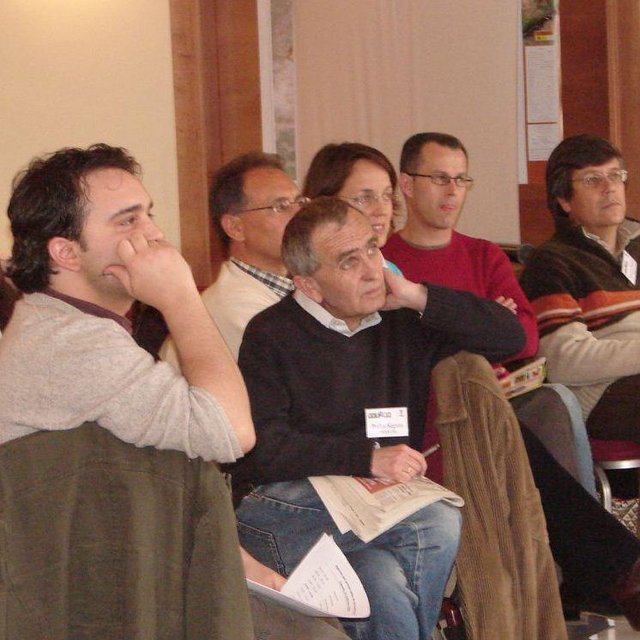
Discussion in a workshop on the usefulness of soil conservation measures and the need for agricultural subsidies. (Joris de Vente)
គោលបំណងនៃវិធីសាស្រ្តផ្សព្វផ្សាយនិងបរិស្ថានអំណោយផល
គោលបំណងនៃវិធីសាស្រ្តផ្សព្វផ្សាយ
The Approach focused mainly on SLM with other activities (Socio-economic development of rural areas)
1) improve the socio-economic situation of rural areas; 2) prevent land abandonment; and 3) prevent on-site and off-site damage caused by land degradation and erosion.
The SLM Approach addressed the following problems: The main problems addressed by the approach are low income and low productivity of farmers in rural areas, subsequent land abandonment, and erosion and land degradation processes causing on-site and off-site damage.
លក្ខខណ្ឌអំណោយផលដល់ការអនុវត្តបចេ្ចកទេសដែលបានប្រើក្នុងវិធីសាស្រ្តផ្សព្វផ្សាយ
លក្ខខណ្ឌរាងរាំងដល់ការអនុវត្តបចេ្ចកទេសដែលបានប្រើក្នុងវិធីសាស្រ្តផ្សព្វផ្សាយ
-
សង្គម/វប្បធម៌/ និងតម្លៃនៃសាសនា: The problem is not always recognised by everyone and certain practices are cultural.
Treatment through the SLM Approach: Information and training by the regional extension services and the agricultural organisations.
-
ភាពអាចរកបាននៃធនធានហិរញ្ញវត្ថុ និងសេវាកម្ម: Many technologies require an investment and maintenance, or even reduce productivity because they occupy land
Treatment through the SLM Approach: A subsidy equal to the loss of productivity and implementation and maintenance costs.
-
ចំណេះដឹងស្តីពី SLM និងការទទួលបានការគាំទ្រផ្នែកបច្ចេកទេស: Some technologies require establishment of vegetation cover, which is difficult under arid conditions.
Treatment through the SLM Approach: Advice about which vegetation types to use and subsidy to cover the implementation costs.
ការចូលរួមនិងតួរនាតីរបស់ភាគីពាក់ព័ន្ធដែលចូលរួម
ភាគីពាក់ព័ន្ធដែលចូលរួមក្នុងវិធីសាស្រ្តផ្សព្វផ្សាយ និងតួរនាទីរបស់គាត់
| តើមានភាគីពាក់ព័ន្ធ/ភ្នាក់ងារអនុវត្តន៍ណាខ្លះដែលបានចូលរួមក្នុងវិធីសាស្ត្រផ្សព្វផ្សាយ? |
សូមបញ្ជាក់ភាគីពាក់ព័ន្ធ |
សូមពណ៌នាតួនាទីរបស់ភាគីពាក់ព័ន្ធ |
| អ្នកប្រើប្រាស់ដីក្នុងតំបន់/សហគមន៍ |
Farmer organisations (agricultural cooperatives)
Traditionally land users and agricultural activities are dominated by men |
The focus of the approach is on the socioeconomic situation of farmers with a relatively low income and under marginal conditions. |
| អ្នកឯកទេសគ្រប់គ្រងដីប្រកបដោយចីរភាព/ទីប្រឹក្សាបច្ចេកទេសកសិកម្ម |
Research institutes |
|
| រដ្ឋាភិបាលថ្នាក់មូលដ្ឋាន |
regional ministry of agriculture |
|
| រដ្ឋាភិបាលថ្នាក់ជាតិ (អ្នករៀបចំផែនការ អ្នកសម្រេចចិត្ត) |
Part of the subsidies are paid directly by the national government |
|
| អង្គការអន្តរជាតិ |
Part of the subsidies are paid through the EU feader programm |
|
ការចូលរួមពីអ្នកប្រើប្រាស់ដីឬសហគមមូលដ្ឋានក្នុងតំណាក់កាលផ្សេងគ្នានៃវិធីសាស្រ្តផ្សព្វផ្សាយ
គ្មាន
អសកម្ម
ការគាំទ្រពីខាងក្រៅ
អន្តរកម្ម
គំនិតផ្តួចផ្តើមដោយខ្ឡួនឯង
ការចាប់ផ្តើម/ការលើកទឹកចិត្ត
Petitions towards policy makers and farmers organizations to pay attention for production under difficult environmental conditions
ការរៀបចំផែនការ
Land users were sporadically consulted through farmers organizations and participated in protest meetings against initial versions of the RDP that they considered insufficient regarding payments for the agricultural sector
ការអនុវត្តន៍
Land users implemented SLM technologies themselves with help from technicians of regional government and farmers organisations
ការត្រួតពិនិត្យ និងវាយតម្លៃ
គំនូសបំព្រួញ
To be fit for purpose, since 2007 the RDPs are designed at the regional level using advice from scientific institutes. The boundary conditions regarding the overall environmental and economic objectives and available finances are received from the European and national level. The regional extension services have a role in the dissemination of information and control of correct implementation of measures by farmers.
ការសម្រេចចិត្តលើការជ្រើសរើសបច្ចេកទេស SLM
ការសម្រេចចិត្តត្រូវបានធ្វើដោយ
-
អ្នកប្រើប្រាស់ដីដោយខ្លួនឯងផ្ទាល់ (គំនិតផ្តួចផ្តើមដោយខ្លួនឯង)
-
អ្នកប្រើប្រាស់ដី ដោយមានការគាំទ្រពីអ្នកជំនាញឯកទេស SLM
-
គ្រប់ភាគីពាក់ព័ន្ធទាំងអស់ដែលជាផ្នែកនៃវិធីសាស្រ្តផ្សព្វផ្សាយដោយមានការចូលរួម
-
អ្នកជំនាញឯកទេស SLM បន្ទាប់ពីបានប្រឹក្សាយោបល់ជាមួយអ្នកប្រើប្រាស់ដី
-
អ្នកជំនាញឯកទេស SLM តែឯង
-
អ្នកនយោបាយ /អ្នកដឹកនាំ
ការសម្រេចចិត្តត្រូវបានធ្វើដោយផ្អែកលើ៖
-
វាយតម្លៃទៅលើចំណេះដឹងស្តីអំពី SLM ដែលបានចងក្រងជាឯកសារបានត្រឹមត្រូវ (ផ្អែកលើភស្តុតាងជាមូលដ្ឋានដើម្បីសម្រេចចិត្ត)
-
លទ្ធផលបានពីការស្រាវជ្រាវ
-
បទពិសោធន៍ និងគំនិតផ្ទាល់ខ្លួន(ពុំមានចងក្រងជាឯកសារ)
ការគាំទ្របច្ចេកទេស ការកសាងសមត្ថភាព និងការគ្រប់គ្រងចំណេះដឹង
សកម្មភាព ឬសេវាកម្មខាងក្រោមបានប្រើជាផ្នែកនៃវិធីសាស្ត្រផ្សព្វផ្សាយ
-
ការកសាងសមត្ថភាព/ បណ្តុះបណ្តាល
-
សេវាផ្តល់ប្រឹក្សាយោបល់
-
ការពង្រឹងសមត្ថភាពស្ថាប័ន (ការអភិរឌ្ឍន៍អង្គភាព)
-
ការត្រួតពិនិត្យ និងវាយតម្លៃ
-
ការស្រាវជ្រាវ
ការកសាងសមត្ថភាព/ ការបណ្តុះបណ្តាល
ការបណ្តុះបណ្តាលបានផ្តល់ដល់អ្នកពាក់ព័ន្ធដូចខាងក្រោម
-
អ្នកប្រើប្រាស់ដី
-
បុគ្គលិកចុះទីវាល/អ្នកផ្តល់ប្រឹក្សាយោបល់
ទម្រង់នៃការបណ្តុះបណ្តាល
-
អនុវត្តន៍ជាមួយការងារ
-
ពីកសិករទីកសិករ
-
ទីតាំងបង្ហាញ
-
ការប្រជុំជាសាធារណៈ
-
វគ្គបណ្តុះបណ្តាល
មុខវិទ្យាដែលបានបញ្ចូល
The technical conditions needed for control were explained to technicians. Training to land users was not provided directly, though advice can be obtained through agricultural organisations and extension services.
សេវាកម្មប្រឹក្សា
សេវាកម្មប្រឹក្សាត្រូវបានផ្តល់ឱ្យ
-
នៅលើដីរបស់អ្នកប្រើប្រាស់ដី
-
នៅមជ្ឈមណ្ឌលជាអចិន្ត្រៃ
Agricultural extension services (Oficina Comarcal Agrari; Key elements: advice, control
Advisory service is inadequate to ensure the continuation of land conservation activities; There is more information and awareness building required for land users. Information is often only available at political/research level and the level of the agricultural cooperatives but not at farm level.
ការពង្រឹងស្ថាប័ន
ស្ថាប័នត្រូវបានព្រឹង/ បង្កើត
-
ទេ
-
បាទ/ច៎ា តិចតួច
-
បាទ/ច៎ា ជាមធ្យម
-
បាទ/ច៎ា បានខ្លាំង
នៅកម្រិតដូចខាងក្រោម
-
ថ្នាក់មូលដ្ឋាន
-
កម្រិតថ្នាក់តំបន់
-
កម្រិតថ្នាក់ជាតិ
ពិពណនាស្ថាប័ន៖ តួនាទី និងការទទួលខុសត្រូវ សមាជិក ។ល។
ប្រភេទនៃការគាំទ្រ
-
ហិរញ្ញវត្ថុ
-
ការកសាងសមត្ថភាព/ បណ្តុះបណ្តាល
-
សម្ភារៈ
សេចក្តីលម្អិតបន្ថែមទៀត
Information to agricultural cooperatives
ការត្រួតពិនិត្យ និងវាយតម្លៃ
bio-physical aspects were ad hoc monitored by government through measurements; indicators: farm visits, sampling of soils for chemical parameters
technical aspects were ad hoc monitored by government through measurements; indicators: farm visits to control the actual implementation of SLM measures
economic / production aspects were ad hoc monitored by land users through measurements; indicators: comparing production between years
area treated aspects were regular monitored by government through observations; indicators: farm visits and mapping with GIS tools
no. of land users involved aspects were regular monitored by government through observations; indicators: documentation of all farmers who participate in the subsidy programme
There were several changes in the Approach as a result of monitoring and evaluation: RDP's are evaluated and redefined every 7 years.
There were several changes in the Technology as a result of monitoring and evaluation: RDP's are evaluated and redefined every 7 years.
ការស្រាវជ្រាវ
ការស្រាវជ្រាវពាក់ព័ន្ធនឹងប្រធានបទខាងក្រោម
-
សង្គមវិទ្យា
-
សេដ្ឋកិច្ច/ទីផ្សារ
-
បរិស្ថានវិទ្យា
-
បច្ចេកវិទ្យា
-
geography
Results from national and international research projects of the last decades were used as well as experimental results from regional and national research institutes like the IMIDA and CSIC.
Research was carried out both on station and on-farm
ការផ្តល់ថវិកា និងការគាំទ្រសម្ភារពីខាងក្រៅ
ថវិកាប្រចាំឆ្នាំគិតជាដុល្លាអាមេរិកសម្រាប់ផ្នែក SLM
-
< 2,000
-
2,000-10,000
-
10,000-100,000
-
100,000-1,000,000
-
> 1,000,000
Precise annual budget: មិនមាន
Approach costs were met by the following donors: international (EU FEADER programme): 41.0%; government: 10.0%; local government (district, county, municipality, village etc): 49.0%
សេវាកម្ម និងការលើកទឹកចិត្តខាងក្រោមត្រូវបានផ្តល់ដល់អ្នកប្រើប្រាស់ដី
-
ការគាំទ្រផ្នែកហិរញ្ញវត្ថុ / សម្ភារៈដែលបានផ្តល់ទៅឱ្យអ្នកប្រើប្រាស់ដី
-
បដិភាគសម្រាប់ធាតុចូលជាក់លាក់
-
ឥណទាន
-
ការលើកទឹកចិត្ត ឬវិធីសាស្ត្រដ៏ទៃទៀត
ការគាំទ្រថវិការ/ សម្ភារដែលបានផ្តល់ដល់អ្នកប្រើប្រាស់ដី
Subsidies are provided by the regional ministry, state and EU programmes.
ផ្តល់ហិរញ្ញវត្ថុមួយផ្នែក
ផ្តល់ហិរញ្ញវត្ថុទាំងស្រុង
កំលាំងពលកម្មដោយអ្នកប្រើប្រាស់ដីគឺ
-
ដោយស្ម័គ្រចិត្ត
-
ធ្វើការងារប្តូរជាអាហារ
-
បង់ជាសាច់ប្រាក់
-
ផ្តល់ជារង្វាន់តាមរយៈការគាំទ្រជាសម្ភារៈ
ការវិភាគផលប៉ះពាល់ និងសេចក្តីសន្និដ្ឋាន
ឥទ្ធិពលនៃវិធីសាស្រ្តផ្សព្វផ្សាយ
ទេ
បាទ/ច៎ា បន្តិចបន្តួច
បាទ/ច៎ា ជាមធ្យម
បាទ/ច៎ា បានខ្លាំង
តើវិធីសាស្ត្រផ្សព្វផ្សាយជួយអ្នកប្រើប្រាស់ដីដើម្បីអនុវត្តន៍ និងថែទាំបច្ចេកទេស SLM?
Awareness and motivation to apply SLM amongst land users has increased due to the approach.
តើវិធីសាស្ត្រផ្សព្វផ្សាយនេះផ្តល់សិទ្ធិអំណាចដល់សង្គមនិងសេដ្ឋកិច្ចដែលក្រុមមិនទទួលបានផលប្រយោជន៍?
Because of the approach the economic situation of farmers in marginal areas is slightly improved.
Did other land users / projects adopt the Approach?
RDPs are developed for all regions in Spain, and need approval from national government and from the EU.
ការជំរុញទឹកចិត្តសំខាន់បំផុតនៃអ្នកប្រើប្រាស់ដីក្នុងការអនុវត្ត SLM
-
បង្កើនផលិតកម្ម
-
បង្កើនប្រាក់ចំណេញ (សមត្ថភាព) បង្កើនអត្រាចំណេញ
-
ការកាត់បន្ថយការធ្លាក់ចុះគុណភាពដី
-
កាត់បន្ថយហានិភ័យនៃគ្រោះមហន្តរាយ
-
កាត់បន្ថយទំហំការងារ
-
ការចំណាយ/បដិភាគ
-
ច្បាប់ និងបទបញ្ជា (ផាកពិន័យ)/ការប្រតិបត្តិ
-
កិត្តិនាម សម្ពាធសង្គម/ការផ្សាភ្ជាប់ទៅនឹងសង្គម
-
ការផ្សារភ្ជាប់ទៅនឹងចលនា/គម្រោង/ក្រុម/បណ្តាញ
-
ពង្រឹងស្មារតីផ្នែកបរិស្ថាន
-
ទម្លាប់ និងជំនឿ សីលធម៌
-
លើកកម្ពស់ចំណេះដឹង និងជំនាញ SLM
-
ការកែលម្អសោភ័ណ្ឌភាព
-
ការកាត់បន្ថយជម្លោះ
និរន្តរភាពនៃសកម្មភាពផ្សព្វផ្សាយ
តើអ្នកប្រើប្រាស់ដីអាចបន្តដោយនិរន្តរភាពនូវអ្វីដែលបានអនុវត្តតាមរយៈការផ្សព្វផ្សាយ (ដោយមិនមានការគាំទ្រពីខាងក្រៅ)?
សេក្តីសន្និដ្ឋាន និងមេរៀនបទពិសោធន៍
ភាពខ្លាំង: ទស្សនៈអ្នកប្រើប្រាស់ដី
-
All implementation and maintenance costs as well as loss of productivity are subsidised (How to sustain/ enhance this strength: There should be enough funding for all farmers willing to apply the measures, and there should be continuity across RDP’s.)
ភាពខ្លាំង: ទស្សនៈរបស់អ្នកចងក្រង ឬបុគ្គលសំខាន់ផ្សេងទៀត
-
The approach is an effort to provide an integrated way of how SLM can be achieved. So no separate measures but a complete SLM plan at the farm level. (How to sustain/ enhance this strength: Including more measures in the approach.)
ចំណុចខ្សោយ/ គុណវិបត្តិ/ ហានិភ័យ : ទស្សនៈអ្នកប្រើប្រាស់ដីវិធីដោះស្រាយ
-
There is a lack of organisation amongst land users
Agricultural cooperatives and regional extension services should have a more active role to coordinate activities and communication.
ចំណុចខ្សោយ/ គុណវិបត្តិ/ ហានិភ័យ : ទស្សនៈរបស់អ្នកចងក្រង ឬបុគ្គលសំខាន់ផ្សេងទៀតវិធីដោះស្រាយ
-
There is a strong lack of land users participation in the design, implementation and training of the approach
Organise stakeholder meetings, information sessions and trainings for land users.
-
There is a lack of transparency in communication
Agricultural cooperatives and regional extension services should have a more active role to coordinate activities and communication.
ឯកសារយោង
អ្នកត្រួតពិនិត្យ
-
David Streiff
-
Deborah Niggli
កាលបរិច្ឆេទនៃការអនុវត្ត: 12 ខែ ឧសភា ឆ្នាំ 2009
កែតម្រូវចុងក្រោយ: 4 ខែ មេសា ឆ្នាំ 2018
បុគ្គលសំខាន់ៗ
-
Joris De Vente (joris.devente@geo.kuleuven.ac.be) - អ្នកជំនាញឯកទេស SLM
-
Albert Solé Benet (albert@eeza.csic.es) - អ្នកជំនាញឯកទេស SLM
ការពណ៌នាលម្អិតក្នុងប្រព័ន្ធគ្រប់គ្រងទិន្នន័យរបស់វ៉ូខេត
ឯកសារនេះត្រូវបានសម្របសម្រួលដោយ
ស្ថាប័ន៖
- EEZA-CSIC (EEZA-CSIC) - ប្រទេសអេស្ប៉ាញ
គម្រោង
